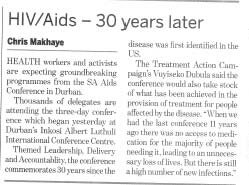HIV/AIDS: Two’s a crowd
JournAIDS
13 June 2011
While it used to be accepted practice to write HIV and AIDS as HIV/AIDS, there are a number of reasons why it is a now a stylistic no-no.

Many headlines have named this month as the “30th anniversary of HIV”. Others lump HIV and AIDS together, making June the “30th anniversary of HIV/AIDS,” or looking back on “30 years of HIV/AIDS.”
The latter example which features the HIV/AIDS coupling that so often mars what is otherwise good journalism, is incorrect because HIV and AIDS are not the same thing but are medically distinct from one another.
The human immunodeficiency virus (HIV) weakens the human body’s immune system allowing the opportunistic diseases which are associated with AIDS to take hold.
This means that a person can have HIV and not have AIDS, but a person cannot have AIDS and not be HIV-positive. It is not HIV itself that kills the person it is the diseases that are able to invade the body because of the effects of the virus that are the actual cause of death.
Many HIV-positive people can live healthy AIDS free lives for decades; this is why it does not make sense and is misleading to write about HIV or AIDS as HIV/AIDS.
Taking into account the above, one can see why labeling June as the 30th anniversary of the discovery of HIV is to confuse the issue. The statement is incorrect because June is in fact the 30th anniversary of, specifically, the first recorded AIDS related deaths, not the anniversary of the discovery of the virus itself.
The HI-virus has been around from the early 1900s, therefore people probably suffered from HIV and progressed to having AIDS much earlier than the 1980s, but the effects of the virus only became visible in 1981. The reason for its appearance at this time and in the western context was because the virus had moved out of Africa- where it had gone largely unnoticed- to developed countries which were better equipped to detect it.
In 1981 doctors noticed a surge in deaths from opportunistic infections in young gay men in New York. The medical community was baffled initially as they could find no medically plausible reason for why the individuals should be vulnerable to diseases which usually affected older or already sick individuals.
Doctor’s christened the condition Gay-related immune deficiency (GRID) but they were soon to discover that the condition did not confine itself to homosexual men. Cases were later seen in women and children too.
Only in 1984 did doctors ‘discover’ HIV, which was what caused the AIDS deaths.
It is important for media practitioners to get the small technical details right because the public glean so much information from their daily newspaper. Combining HIV and AIDS into the HIV/AIDS ‘duo,’ communicates the wrong message in terms of HIV progression and treatment and may affect attitudes towards those who are HIV-positive.
Specifically the discovery of the first AIDS related cases paved the way for stigma when the condition was exclusively associated with homosexual people. In contrast to this the discovery of the virus represented the opportunity to decouple AIDS and homosexuality, reducing social stigma.
The same goes for representing June as the ‘anniversary of HIV.’ This kind of journalistic faux pas only serves to confuse the essential facts around HIV and AIDS. While it may have been considered acceptable to write HIV and AIDS as HIV/AIDS a few years ago, developments in HIV treatment have allowed HIV and AIDS to be medically, and now socially separated.
blog comments powered by Disqus


